Augmented Reality
 sejal khatri
sejal khatri
Introduction:
Augmented Reality (AR) has emerged as a transformative technology, blurring the boundaries between the physical and digital worlds. With applications spanning various industries, AR enriches our daily experiences by overlaying computer-generated content onto the real world. This article explores the evolution, key applications, challenges, and the promising future of augmented reality.
Evolution of Augmented Reality:
The roots of augmented reality can be traced back to the 1960s, but significant advancements have occurred in recent decades. The convergence of powerful mobile devices, advanced sensors, and sophisticated software has propelled AR into the mainstream. What began as experimental concepts has evolved into practical applications that impact how we learn, work, and interact with our surroundings.
Key Applications of Augmented Reality:
Gaming: The gaming industry was one of the early adopters of AR technology. Games like Pokémon Go brought AR into the mainstream by allowing users to interact with virtual elements in the real world. This fusion of digital and physical environments created a new dimension of gaming experiences.
Education: Augmented reality has transformed education by providing interactive and immersive learning experiences. AR applications allow students to explore 3D models, conduct virtual experiments, and engage with educational content in a more dynamic way.
Retail and E-commerce: In the retail sector, AR enhances the shopping experience. Customers can use AR to visualize how furniture or clothing items will look in their homes or on themselves before making a purchase. This feature has revolutionized online shopping and reduced the number of product returns.
Healthcare: AR applications in healthcare aid in surgical planning, medical training, and patient care. Surgeons can use AR to visualize critical information during procedures, and medical students can practice surgeries in a simulated environment.
Enterprise and Industry: Augmented reality is utilized in various industries for tasks such as remote assistance, maintenance, and training. AR glasses or devices enable workers to access information hands-free, improving efficiency and reducing errors.
Challenges in Augmented Reality:
Hardware Limitations: Despite advancements, AR hardware still faces challenges in terms of size, weight, and field of view. Improving these aspects will be crucial for a more seamless and widespread adoption of AR devices.
Content Creation: Creating compelling and meaningful AR content can be challenging. Developing content that seamlessly integrates with the physical environment and enhances user experiences requires a combination of creativity and technical expertise.
Privacy Concerns: AR applications often involve collecting and processing real-world data. Addressing privacy concerns and ensuring secure handling of user information are paramount for the responsible development of AR technologies.
The Future of Augmented Reality:
As technology continues to advance, the future of augmented reality holds tremendous promise. Anticipated developments include more compact and affordable AR devices, improved content creation tools, and enhanced integration with other emerging technologies such as artificial intelligence.
Conclusion:
Augmented reality stands at the intersection of the physical and digital realms, offering innovative solutions and transforming various aspects of our lives. As AR technology evolves, its applications will likely become even more widespread, reshaping industries, enhancing experiences, and bringing a new layer of richness to our interactions with the world around us. The journey of augmented reality is an ongoing exploration of the possibilities that arise when the virtual and physical seamlessly coexist.
Subscribe to my newsletter
Read articles from sejal khatri directly inside your inbox. Subscribe to the newsletter, and don't miss out.
Written by
